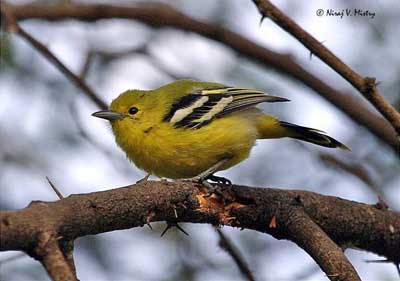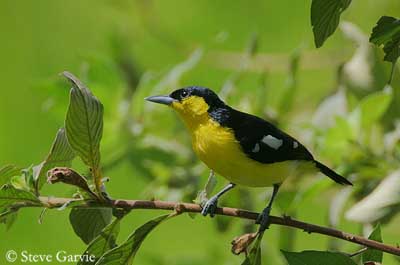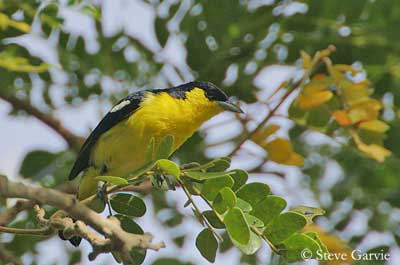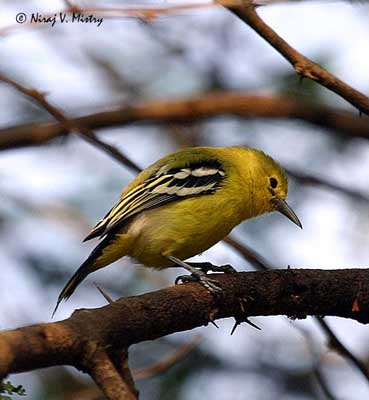
Common Iora
Aegithina tiphia
Passeriforme Order – Aegithinidae family
BIOMETRICS:
Length: 13-17cm
Weight: 13,5 gr
DESCRIPTION:
Common Iora is a small bird living high up in the canopy.
PROTECTION / THREATS / STATUS:
Common Iora is common and widespread. Populations are not threatened. Its range is expanding due to creation of orchards and gardens, and it takes part in pest control in fruit orchards.
Fr : Petit iora
All : Schwarzflügel-Aegithina
Esp : Iora Común
Ital : Iora comune
Nd : Dwergbuulbuul
Photographers:
Niraj V. Mistry
Photo Galleries
Steve Garvie
RAINBIRDER Photo galleries
Didier Buysse
Vision d’Oiseaux
Text by Nicole Bouglouan
Sources:
LES OISEAUX DE THAILANDE par Roland Eve et Anne-Marie Guigue - Times Editions - ISBN: 9812042008
L’ENCYCLOPEDIE MONDIALE DES OISEAUX - Dr Christopher M. Perrins - BORDAS - ISBN: 2040185607
Wikipedia (Wikipedia, The Free Encyclopedia)
BirdLife International (BirdLife International)

Adult male in breeding plumage has dark green to black upperparts. Wings are black with white wing bars. Tail is blackish. Rump is greenish.
Underparts are bright yellow, with larger white feathers on flanks.
Breeding male has black crown, but face is bright yellow.
Pointed bill is blue-grey. Eyes are black. Legs and feet are slate blue-grey.
Non breeding male has greenish upperparts, almost as female. This one has also greenish upperparts and dull yellow underparts, forehead and eyebrow, and olive-green crown. Wings are grey-black.
We can find some subspecies:
Aegithina tiphia multicolor, from Sri Lanka and Southern India. It has black crown and back.
Aegithina tiphia tiphia, from the Hymalayas. It has entirely green upperparts.
Aegithina tiphia humei, from Southern Asia. It has black crown, and black and green back.
VOICE: SOUNDS BY XENO-CANTO
Common Iora can produce a variety of notes. It utters some mournful whistles. Most classical call is a whistled note, slightly quavering, or several notes ending with a sudden modulation “whiiiiii-tiu” or tui-tiii-tiu”. It utters variable chirrs and chattering. Song is a trill “wheeeee-tee”.
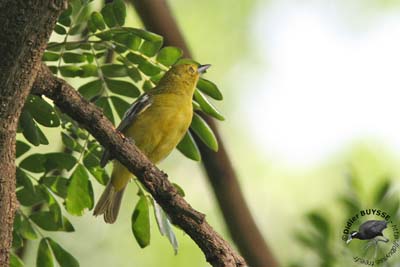
HABITAT:
Common Iora lives in forests and well wooded areas, scrubs, cultivated areas and gardens. It avoids deep forests.
RANGE:
Common Iora lives in India to SW China, and Southeast Asia.
BEHAVIOUR:
Common Iora feeds mainly on insects, searching for them from leaves high in the canopy. It may sometimes hanging upside down from branches. It catches insects on the wing. It feeds in pairs or in small groups. It is a very active bird.
Common Iora has spectacular courtship displays. Male performs acrobatic flights. It darts up into the air, at about one or two metres, and fluffs its rump feathers, and the long white flank feathers. Then, it spirals down to its perch where it spreads its tail as a fan, and drops its wings. During these displays, male utters soft, mournful whistles, or alternatively, a continuous chirrup.
Common Iora is monogamous.
It tends to stay up in high trees, but also in edges of bushes, hedges and paths. It is relatively difficult to see it.
Outside breeding season, Common Iora travels in pairs or small groups, hunting insects on the wing, and uttering contact calls through frequent sounds.
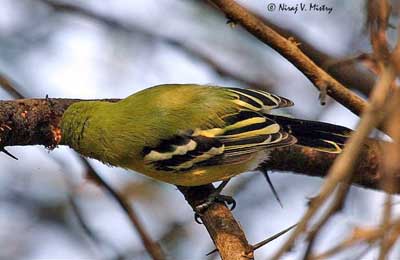
FLIGHT:
Common Iora performs acrobatic flight displays, darting up and spiralling down to a perch.
REPRODUCTION:
Common Iora’s nest is usually situated in a fork, at the end of a branch, in small tree.
Nest is a loose, deep cup, made with grass and plant fibres woven together, and consolidated with silk of spider webs on the external side.
Female lays 2 to 4 greenish-white eggs, blotched and spotted with reddish-brown.
Any other information is available about the nesting behaviour of this species.
DIET:
Common Iora feeds mainly on insects such as grasshoppers, caterpillars, dragonflies and mantises. It also consumes spiders and small insects, fruit, berries and nectar.
